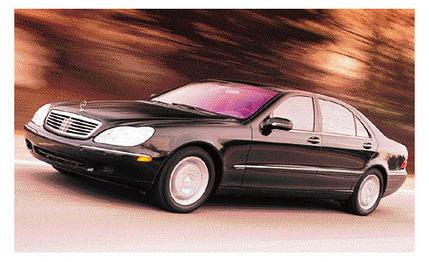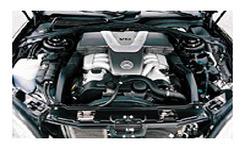
 Road Test
Road Test
It is said that the most precious commodity among the upper echelon of America's working class these days--more valuable than diamonds, Berkshire Hathaway shares, or even a full head of natural-looking hair--is time. And the net worth of every millisecond of "free time" will continue to skyrocket as our workdays lengthen, as urban sprawl extends commuting distances, and as traffic density chokes the existing road system. Road rage is a reaction to these pressures, and now multitasking is being proffered as a solution. Keep drivers busy enough, and maybe they won't shoot one another. Behold the poster child for vehicular multitasking: Mercedes-Benz's flagship sedan, the S600. For the hands-on plutocrat who refuses to be driven, there is no better self-propelled, land-bound way to get somewhere quickly while simultaneously keeping tabs on a corporate empire. Like all 2001 Mercedes-Benzes, the S-class comes standard with a Tele Aid cell-phone link to keep the driver in touch with the factory or emergency services. But Mercedes was first to market with an "Internet on wheels" telematics system, available for 2001 on all models equipped with a COMAND navigation system (standard on S- and CL-classes, a $2035 option on C-, CLK-, and E-class cars). CNN Interactive beams the Web content to the car for an annual fee of $125, plus air time.


Customers can have their own personal Web page on the www.mbusa.com site, and it can be personalized to track stocks of interest, news topics, sports, weather, etc. Text can then be downloaded and displayed on the screen at the touch of the "SVC" button in the COMAND cluster.
Calendar reminders are also available for the harried exec on a tight schedule. COMAND admonishes Mr. Big to wait until the car is parked to read the text, but it can be displayed on the fly. Expect many upgradable Web-related features to be added throughout the useful life of a new 2001 Mercedes, but for now all data transmission comes across at the protracted pace of 9600 bits per second.
File attachments and photos are therefore out of the question (eliminating a whole category of naughty driver distractions). Ah, the question does come up--do human beings, especially those who've circled the sun enough times to amass the wealth required to acquire an S-class, really have the excess mental processing capacity to manage steering, acceleration, braking, and Web surfing tasks simultaneously? Perhaps not, but never fear--Distronic intelligent cruise control offers to temporarily relieve his or her highness of the tiresome tasks of accelerating and braking to keep pace with the ebb and flow of rush-hour freeway traffic, for just $2800 plus tax.
The Technical Highlights sidebar examines the guts of this gizmology, but suffice to say that we were able to enter the freeway outside Hogback Tower, engage the cruise control at 75 mph, and commute 40 miles along four different freeways through moderately thick evening traffic without touching the pedals. Distronic slowed us to 30 or 40 mph following traffic around the various cloverleafs. It braked indignantly when oblivious SUV drivers swerved in front and then surged silently back up to cruising speed when the coast was clear.
The system can be set to follow between one and two seconds behind the car in front, which means the distance to the next car varies with speed. We found the minimal distance to be most effective in thick 40-to-70-mph traffic, as it left insufficient space for any but the most aggressive lane jockey to jump in front. Applying the throttle to drive into the "safety bubble" and around an obstruction countermands the braking function.
On an evening drive across the laser-infested Ohio Turnpike to Cleveland, we set Distronic to its maximum following distance (and the maximum set speed of 110 mph), and then latched on, tractor-beam-like, to whoever was driving fastest. We never hit 110, but we were traveling as fast as possible without making a target of the big black Benz. At 70 mph, one has about three seconds to react if the warning beeper sounds for an object within 300 feet, so paying attention is still a good idea, particularly considering the system occasionally loses track of a target car that is still very much in view. (This tends to happen mostly on curves, and for that reason, the system won't accelerate to resume a set speed on a curve.)